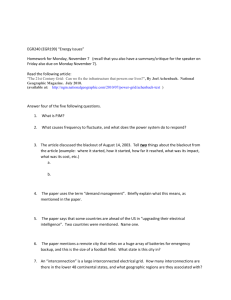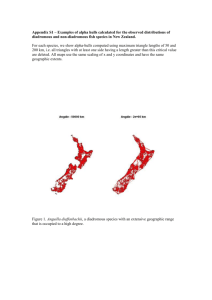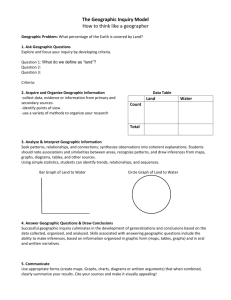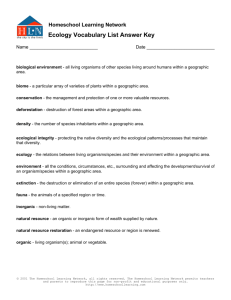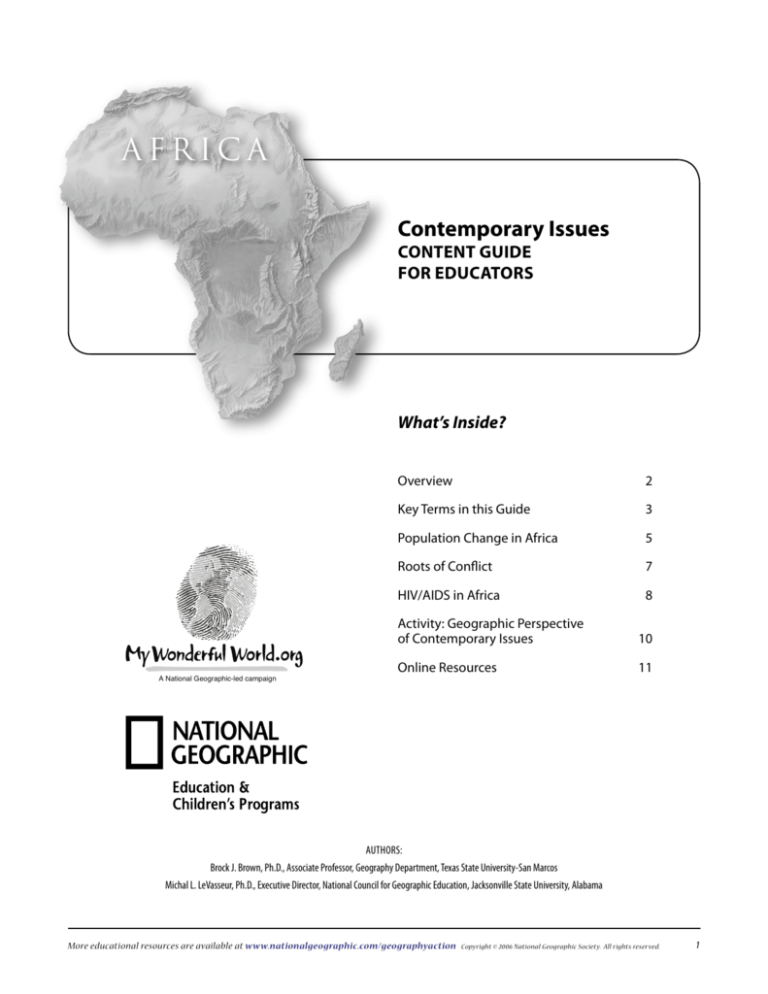
Africa
Contemporary Issues
Content Guide
for educators
What’s Inside?
A National Geographic-led campaign
Overview
2
Key Terms in this Guide
3
Population Change in Africa
5
Roots of Conflict
7
HIV/AIDS in Africa
8
Activity: Geographic Perspective of Contemporary Issues
10
Online Resources
11
Authors:
Brock J. Brown, Ph.D., Associate Professor, Geography Department, Texas State University-San Marcos
Michal L. LeVasseur, Ph.D., Executive Director, National Council for Geographic Education, Jacksonville State University, Alabama
More educational resources are available at www.nationalgeographic.com/geographyaction
Copyright © 2006 National Geographic Society. All rights reserved.
Content Guide:
Contemporary Issues of Africa
2 of 16
Overview
T
he geographic perspective and geographic skills
can be utilized to enhance our understanding of the
contemporary issues in Africa, or in any region. A geographic
perspective prompts us to consider the issue in its spatial context,
how it came to be an issue in that location, how it links to other
places and people, and what the effects of the issue are on
particular places and people.
As educators we can help our students add the spatial and
ecological dimension to an understanding of contemporary
issues. Infusing contemporary issues into the curriculum can add
relevance and timeliness to concepts being studied. Using the
geographic perspective, one may explore contemporary issues
such as these in Africa.
Poverty/employment
(Example: Persistent poverty in South Africa)
Warfare/conflict/refugees
(Example: Genocide in Darfur, Sudan)
Desertification
(Example: Sudano-Sahelian region)
Deforestation
(Example: Rain forests in the Democratic Republic of the Congo)
Wildlife conservation
(Example: Protecting Madagascar’s biodiversity)
Access to clean water
(Example: Rural water projects in Ghana)
Children from poor families sometimes work. (Benin)
Urbanization
(Example: Nigerian cities)
Corruption / government
(Examples: Multipartyism in Kenya, corruption under Haile
Selassie in Ethiopia)
Status of women
(Examples: Female circumcision in Guinea;
entrepreneurship and business training in Nigeria)
Wildlife and land conservation (Examples: Conservation efforts
throughout the heartland of Africa include Kilimanjaro and the
Maasai Steppe; Tanzania, Zambia, and Botswana have officially
protected more than 30 percent of their land)
Involving students in a geographic inquiry provides an
engaging way for students to practice developing skills of
inquiry, collecting, organizing and evaluating different forms of
information, and presenting the answers to their questions.
Education and literacy
(Example: Lifelong education in Botswana)
More educational resources are available at www.nationalgeographic.com/geographyaction
Copyright © 2006 National Geographic Society. All rights reserved.
Content Guide:
Contemporary Issues of Africa
3 of 16
Key Terms in this Guide
Carrying Capacity – the number of people the Earth can support
as a whole, or can support in a specific region
Culture – the highly integrated, total way of life for a group
of people; it is learned; it forms an integrated whole; and it is
unique to humans
Ecological perspective – the view one has when he or she
explores the relationships between the physical and human
environments
Geographic perspective – the perspective used by geographers
when they use all available data and tools to first assess spatial
distributions, then investigate the underlying spatial processes
responsible for the observable spatial distributions, and finally
make spatial predictions and decisions about how best to
preserve or change the distributions
Migration – movement of humans or animals from one place
to another; it is the predominant process that contributed to
the spread of human populations over Earth at the global scale
and is evident in the population distribution of today at the
regional and local scale; it contributes to cultural diffusion and
influences demographics, ethnicity, economics, culture, and
social characteristics
Population – people; the term implies human need and
economic demand for resources
Refugee – a person who flees his place of habitual residence
to seek refuge in another place outside his country of origin
or nationality, as in times of war, political oppression,
environmental destruction, or religious persecution
Region – a human construct that attempts to generalize
complex physical and cultural spatial distributions so that
they can be understood (regions can be formal or functional;
definitions for cultural regions only given here)
• Formal Cultural Region – represents the spatial distribution
of cultural traits
• Functional Cultural Region – represents the deliberate
organization of space to accomplish some function
Resources – something defined as valuable by a group of
people; the value of a resource can be created by a culture, and
the value of a resource can be destroyed, as well
Spatial distribution – the distribution in Earth space of
anything that exists and can be observed and mapped; not
random but due to spatial processes
• Can be natural/physical such as precipitation,
temperature, or soil
• Can be cultural, such as language, religion, or gender equality
• Can also be the result of humans interacting with the
environment, for example, soil erosion, deforestation, or
habitat loss due to urban sprawl
More educational resources are available at www.nationalgeographic.com/geographyaction
Copyright © 2006 National Geographic Society. All rights reserved.
Content Guide:
Contemporary Issues of Africa
4 of 16
Key Terms in this Guide con’t.
Spatial process – an underlying process responsible for the way
something is distributed over Earth space
• Spatial distributions in the natural/physical environment are
due to spatial processes; energy and matter working in the
Earth’s physical system
• Cultural patterns are not random, either, but due to spatial
processes, primarily innovation/invention or more likely
spatial diffusion
Technology – the use of tools, energy, and human creativity to
identify and extract resources from the environment that people
need, want, and can generate demand for in the global economy;
the ability of a group of people to use energy and technology to
extract resources from the environment is closely tied to standard
of living
More educational resources are available at www.nationalgeographic.com/geographyaction
Copyright © 2006 National Geographic Society. All rights reserved.
Content Guide:
Contemporary Issues of Africa
5 of 16
Population Change in Africa
An issue of significance for a number of African countries is the pattern of population change. Human migration affects the distribution
of population and the size of the population in particular areas. Population sizes and distributions also change in response to demographic
characteristics of the population, such as birth rate, death rate, rate of natural increase, fertility rate, etc. Each of these characteristics has
a spatial distribution and can help us to understand the dynamics of population increase in Africa. The ecological perspective can help
us understand the impact that population growth has on such issues as settlement patterns, land use, food security, and the availability
of resources.
As humans interact with the environment to extract resources, they impact and modify existing spatial distributions and underlying
spatial processes of the environment. The number of people and the length of time they are in an area influence the degree to
which they will impact it. More recently, the level of technology a group of people possesses has become one of the most important
variables in determining the degree and “spatial extent” that people impact the environment. Over the past few thousand years, human
developments in technology have increased our ability to extract resources. This has, in turn, increased the number of humans that
the planet can support, or the carrying capacity. It is believed that the Earth’s population 2,000 years ago was about 250-300 million
people. Today it is about 6.5 billion. The level of technology 2,000 years ago would not have supported today’s population. Advances in
technology have expanded the carrying capacity and made it possible for so many people to live on the planet.
More educational resources are available at www.nationalgeographic.com/geographyaction
Copyright © 2006 National Geographic Society. All rights reserved.
Content Guide:
Contemporary Issues of Africa
6 of 16
Cultural-Economic Activity
Human
Need/
Wants
Demand
Energy and Technology
Environment
Resources
Cultural
traits
Human-Environmental
Interactions
Key facts:
• Rapid population growth is causing human need to exceed
resources in some areas of Africa.
a. The area around Lake Victoria, in East Africa, has a
significantly higher population density than most of
the rest of Africa due to the wealth of natural resources
and economic benefits.
b. More forests and grasslands are being converted to
agricultural land use in order to produce food for
growing populations.
c. Expansion of domesticated animal populations has created
tension over land use for pasture, agriculture, and wildlife
habitat.
d. Land use patterns coupled with semiarid soils and
drought have expanded the process of desertification in
Africa, especially in the Sahel region.
e. More land, including prime agricultural land, is being
converted for urban use as the rural-to-urban migration
rate increases in Africa.
• The migration of refugees within countries and between
countries is changing some population distribution patterns.
• Urbanization is increasing as a result of the rural-to-urban
migration. At the present trend, half the population of Africa
may be urban by 2025.
• Tendency toward urban primacy, in which one city is dominant
in a country and at least three times larger in population than
the next largest city.
More educational resources are available at www.nationalgeographic.com/geographyaction
Copyright © 2006 National Geographic Society. All rights reserved.
Content Guide:
Contemporary Issues of Africa
7 of 16
Roots of Conflict in Africa
Religion and language (the spatial distributions of which form formal cultural regions) are two of the most central elements of culture.
Spatial distributions of religion and language are strong indicators of the distribution of culture. As a result of imperialism, African
political boundaries are often incompatible with the spatial distribution of language and/or religion. In other words, cultural groups are
dissected by political boundaries. These unnatural divisions are often a source of tension and conflict.
The map below, “Africa: Political Boundaries (Functional Cultural Regions),” indicates political boundaries of five regions of Africa
(functional cultural regions). Compare this map with thematic maps showing language and/or religion. (The spatial distribution of an
ethnic and/or national group can often be illustrated by the distribution of a language, or of a religion.)
Are there examples of where ethnic/national groups (formal cultural regions), as indicated by the spatial distribution of language, are
dissected by political boundaries? Are there examples of where the spatial distribution of religion that indicate that political boundaries
dissect ethnic/national groups? If so, what contemporary conflicts might exist as a result of these incompatible distributions?
Africa: Political Boundaries (Functional Cultural Regions)
NORTHERN AFRICA
WESTERN AFRICA
MIDDLE AFRICA
0
0
8 0 0 mi
800 km
(Regions defined by the
PRB 2006 World Population Data Sheet)
EASTERN AFRICA
SOUTHERN AFRICA
More educational resources are available at www.nationalgeographic.com/geographyaction
Copyright © 2006 National Geographic Society. All rights reserved.
Content Guide:
Contemporary Issues of Africa
8 of 16
HIV/AIDS in Africa
One of the most pressing issues for human life is the challenge of HIV, the virus that causes AIDS. This epidemic affects at least 40 million
people now living with HIV. While global in scope, the region most severely impacted is sub-Saharan Africa. A recent publication of the
Population Reference Bureau, The Global Challenge of HIV and AIDS (March 2006), reports that an estimated 4.9 million people were newly
infected with HIV in 2005. Of this number, 95 percent of them lived in sub-Saharan Africa, Eastern Europe, or Asia.
The United Nations and the World Health Organization recognize the Africa epidemic of HIV and AIDS as a highly varied outbreak across
the continent. Initially, HIV spread in a band from West Africa across to the Indian Ocean, beginning in the late 1970s and early 1980s. It
then began moving to the southern countries, where it is now most prevalent. As of 2004, South Africa had the most cases in the world,
and Botswana, Lesotho, and Swaziland had the highest percentage of people who were HIV positive. According to the recent 2006
UNAIDS report, India’s 5.7 million cases have surpassed South Africa’s 5.5 million for the highest number of people living with HIV in
the world.
On the next page are some online resources that contain data about the spatial distribution of HIV and AIDS. The formats in which these
data are presented vary, but represent some of the forms in which you and your students are most likely to encounter information. It is
the data, organized and analyzed with a geographic perspective, which will enhance understanding of any contemporary issue.
As you review data, ask yourself the following geographic questions.
•
•
•
•
•
•
What geographic questions do these data raise?
What are the implications for a spatial distribution and underlying processes that explain those distributions?
What is the impact on cultural and physical systems of different regions and countries?
What is the impact on the demographic characteristics and diversity of populations within specific regions or countries?
What other data would help your understanding of the issue?
What predictions would you make for the future of selected regions or countries?
More educational resources are available at www.nationalgeographic.com/geographyaction
Copyright © 2006 National Geographic Society. All rights reserved.
Content Guide:
Contemporary Issues of Africa
9 of 16
Online Resources: Spatial Distribution of HIV and AIDS
AIDS in Africa: Epidemic Map
http://www.aidsinafrica.net/map.php
Interactive map shows current levels of HIV prevalence by country, and spread since 1970 (also GDP per capita, population density,
literacy rate, fertility rate, and highways and mobility)
AIDS in Africa: People Charts
http://www.aidsinafrica.net/people_charts.php
Animated charts, graphs, and diagrams that illustrate statistics and social dimensions of AIDS in Africa
BBC News: The global spread of HIV
http://news.bbc.co.uk/1/shared/spl/hi/africa/03/aids_debate/html/default.stm
Interactive map shows spread of epidemic from 1986 to 2001
U.S. Census Bureau: HIV/AIDS Surveillance Data Base
www.census.gov//ipc/www/hivaidsd.html
Tables and maps of compiled data on HIV/AIDS in developing countries. (Some terms may be unfamiliar. Seroprevalence, HIV I, and HIV II
are defined by the AIDSinfo Glossary, at http://www.aidsinfo.nih.gov/. Kid-friendly definitions of high-risk and low-risk behavior can
be found online at KidsHealth, at http://www.kidshealth.org/teen/sexual_health/stds/std_hiv.html.)
More educational resources are available at www.nationalgeographic.com/geographyaction
Copyright © 2006 National Geographic Society. All rights reserved.
Content Guide:
Contemporary Issues of Africa
10 of 16
Activity: Geographic Perspective of Contemporary Issues
Materials:
• Population Reference Bureau: 2006 World Population Data Sheet (PDF) (one per group)
http://www.prb.org/pdf06/06WorldDataSheet.pdf
• Student atlas of world geography (one per group)
• Paper and pen/pencil
• Large newsprint
• Color markers for newsprint
Step 1. Working in small groups, students should prepare a list of contemporary issues relative to Africa. Each group should write their list
on newsprint so that it can be posted to share.
Step 2. Select one or two issues from the list created in Step 1 for the groups to discuss. On another piece of newsprint, each group should
write its issue(s), and below that write the following three questions, leaving room for answers:
• What is the geographic question that addresses the issue?
• What data is required to answer the question?
• How could you organize and analyze the data?
Step 3. Each group should then answer the geographic questions. Students may consult the PRB World Population Data Sheet or a
student atlas. Groups should then write their answers on the newsprint.
Step 4. Post the newsprint for the class to review.
(For background information about geographic questions, see the Geographic Perspective: Content Guide for Educators PDF, at
http://www.nationalgeographic.com/xpeditions/guides/geogpguide.pdf.)
More educational resources are available at www.nationalgeographic.com/geographyaction
Copyright © 2006 National Geographic Society. All rights reserved.
10
Content Guide:
Contemporary Issues of Africa
11 of 16
Online Resources
Contemporary Issues in Africa Content Guide: Online Resources
Related Links:
National Geographic Guides for Educators: The Geographic Perspective
Written for educators, these National Geographic content guides offer background on and real-world examples of the geographic
perspective, and how it can be applied across the curriculum.
Geographic Perspective: Content Guide for Educators (PDF)
http://www.nationalgeographic.com/xpeditions/guides/geogpguide.pdf
Examples of ways educators can apply the geographic perspective across the curriculum to enhance students’ examination of
complex issues that arise from human interaction with the environment
Africa: Physical Geography Content Guide for Educators (PDF)
http://www.nationalgeographic.com/xpeditions/guides/physicalafricaguide.pdf
Explores ways of teaching physical geography—specifically, of Africa—to students, including location, topography, climate,
vegetation, and rivers. Developed for Geography Action! 2006: Africa.
Africa: Human Geography Content Guide for Educators (PDF)
http://www.nationalgeographic.com/xpeditions/guides/humanafricaguide.pdf
By exploring the cultural landscape of a place, educators can help students understand how people learn and integrate culture—
something unique to humans. Developed for Geography Action! 2006: Africa.
Africa: Contemporary Issues Content Guide for Educators (this guide)
http://www.nationalgeographic.com/xpeditions/guides/contempafricaguide.pdf
How educators can use the geographic perspective to infuse numerous kinds of contemporary issues—in this instance, issues in
Africa—into their curricula. Developed for Geography Action! 2006: Africa.
Africa Multidisciplinary Educator Guide (PDF)
http://www.nationalgeographic.com/xpeditions/guides/multidafricaguide.pdf
This guide offers K–12 educators dozens of resources for teaching about Africa across the curriculum when something new and
interesting is needed. Grouped into four grades bands, the guide lists lesson plans, interactive features, and more that can be used
to teach science, social studies, Language Arts, art, and more. Developed for Geography Action! 2006: Africa.
More educational resources are available at www.nationalgeographic.com/geographyaction
Copyright © 2006 National Geographic Society. All rights reserved.
11
Content Guide:
Contemporary Issues of Africa
12 of 16
Brock Brown’s Geographical Summary of Earth as a Natural/Physical Environmental System
and Humans Interacting with the System (PDF)
http://www.nationalgeographic.com/xpeditions/guides/geogsummary.pdf
This thought-provoking essay explores the Earth’s dynamic energy/matter system and how humans impact that system through
the use of technology. Dr. Brown is an Associate Professor of Geography at Texas State University–San Marcos.
BBC News: Country Profiles
http://news.bbc.co.uk/2/hi/country_profiles/default.stm
History, politics, and economic background of countries and territories; background on key international institutions
CIA: The World Factbook
https://www.cia.gov/cia/publications/factbook/index.html
Maps and country profiles with information about location, geographic coordinates, climate, terrain, land use, irrigated land, and much more
My Wonderful World
http://www.mywonderfulworld.org
Give kids the power of global knowledge with resources from this National Geographic-led campaign—backed by a coalition of major
partners—to expand geographic learning in school, in the home, and in the community.
National Geographic on Africa
http://www.nationalgeographic.com/africa/
Explore Africa with classroom resources, interactive features, photographs, Web sites for kids, and more.
National Geographic EdNet
http://www.ngsednet.org/
The National Geographic free online site for educators—a one-stop shop for education news, resources, discussion, and more
National Geographic EdNet: Classroom Companion Africa Resources
http://www.ngsednet.com/community/resource_uploads/250_08172005_2891.pdf
Comprehensive list of National Geographic resources on Africa
National Geographic: Geography Action! 2006: Africa in 3–D
http://nationalgeographic.com/geographyaction
National Geographic’s annual K-12 conservation and awareness program focused on “Africa in 3-D” in 2006, the first of a five-year, roundthe-world curriculum series.
National Geographic Online
http://www.nationalgeographic.com
Photos, videos, daily news, interactive features, maps, world music, and more, as well as resources for educators and kids
More educational resources are available at www.nationalgeographic.com/geographyaction
Copyright © 2006 National Geographic Society. All rights reserved.
12
Content Guide:
Contemporary Issues of Africa
13 of 16
National Geographic: People and Places: Africa
http://www3.nationalgeographic.com/places/continents/continent_africa.html
Regional and country profiles, fast facts, maps, flags, music, photos, news and many other related features
University of Pennsylvania African Studies Center
http://www.africa.upenn.edu
Up-to-date resources for K–12 teachers include lessons, country pages, images, maps and flags, and links to sites about African
anthropology, population, women’s studies, and more.
AIDS in Africa:
National Geographic News: African Women Assert Themselves in Fight Against AIDS
http://news.nationalgeographic.com/news/2001/01/0117aids.html
UNAIDS: 2006 Report on the Global AIDS Epidemic: Chapter 2—Overview (PDF)
http://data.unaids.org/pub/GlobalReport/2006/2006_GR_CH02_en.pdf
A yearly overview of AIDS worldwide with text, graphs, and tables that illustrate issues, statistics, and trends in Africa by region
(pp. 10–23). (This 43-page PDF is 4MB.)
UNAIDS: Sub-Saharan Africa AIDS Fact sheet 2006 (PDF)
http://data.unaids.org/pub/GlobalReport/2006/200605-FS_SubSaharanAfrica_en.pdf
UN fact sheet lists current AIDS statistics and developing trends
The Washington Post: Special Report: AIDS in Africa
http://www.washingtonpost.com/wp-dyn/world/issues/aidsinafrica/index.html
“Special Report” includes articles, news, commentaries, charts and graphs, more
Other Contemporary Issues in Africa:
International Crisis Group: Crisis in Darfur
http://www.crisisgroup.org/home/index.cfm?id=2700&l=1
Reports, news, and analysis of current situation and options for resolution; maps, geographical information, and photos; more
National Geographic: Africa MegaFlyover—Charting the Last Wild Places on Earth
http://www7.nationalgeographic.com/ngm/megaflyover/
Fueled by a desire for conservation, biologist and explorer Michael Fay undertook an aerial survey to examine the impact of human
activity on the wilderness.
More educational resources are available at www.nationalgeographic.com/geographyaction
Copyright © 2006 National Geographic Society. All rights reserved.
13
Content Guide:
Contemporary Issues of Africa
14 of 16
National Geographic: Shattered Sudan
http://magma.nationalgeographic.com/ngm/0302/feature2/
An oil pipeline fuels the unforgiving heart of a seemingly endless war. It may also be a means to peace.
National Geographic: Somalia—A Failed State?
http://magma.nationalgeographic.com/ngm/0207/feature3/index.html
A civilian army of entrepreneurs and expatriates offers hope in this East African nation, bloodied by warring clans.
National Geographic: Without Borders—Uniting Africa’s Wildlife Reserves
http://www7.nationalgeographic.com/ngm/data/2001/09/01/html/ft_20010901.1.html
In southern Africa transfrontier reserves hold the promise of restoring ecosystems, bolstering tourism, and creating trust among nations
of a war-torn continent.
National Geographic: Zimbabwe—A Land Possessed
http://magma.nationalgeographic.com/ngm/0308/feature5/
With the onset of land reform in Zimbabwe, whites lost farms, blacks lost jobs, and the country that once fed much of southern Africa lost
the means to feed itself.
National Geographic News: Africa Through the Lens of National Geographic News
http://news.nationalgeographic.com/news/2001/07/0731_africafest.html
National Geographic News: Can Central Africa’s Rain Forests Live With Logging?
http://news.nationalgeographic.com/news/2004/11/1118_041118_logging_central_africa.html
National Geographic News: Lions Vs. Farmers: Peace Possible?
http://news.nationalgeographic.com/news/2003/07/0716_030716_lions.html
Rainforestweb.org: Rainforest Region: Africa
http://www.rainforestweb.org/Rainforest_Regions/Africa/
Information portal for online resources of rain forests throughout Africa
CONTEMPORARY ISSUES IN AFRICA: RELATED LESSON PLANS:
EDSITEment: Women in Africa: Tradition and Change (Multiple Grades)
http://edsitement.neh.gov/view_lesson_plan.asp?id=307
Students gain insight into the lives of some black women in sub-Saharan Africa by adopting a perspective that is in part traditional and in
part postcolonial.
More educational resources are available at www.nationalgeographic.com/geographyaction
Copyright © 2006 National Geographic Society. All rights reserved.
14
Content Guide:
Contemporary Issues of Africa
15 of 16
National Geographic: Xpeditions Lesson—Protecting Africa’s Wildlife (Grades K–2)
http://www.nationalgeographic.com/xpeditions/lessons/14/gk2/africawildlife.html
Students consider how people affect the natural environment in their home area and in Africa. They learn about two African habitats
(savanna and rain forest) and some of the animals that live there.
National Geographic: Xpeditions Lesson—Africa’s Struggle with AIDS (Grades 6–8)
http://www.nationalgeographic.com/xpeditions/lessons/01/g68/africaaids68.html
Students come to understand the enormity of the impact of AIDS on the population of Africa by comparing the effect there with its effect
on the population of the world in general, especially the U.S.
National Geographic: Xpeditions Lesson—Seeing the Human Impact on Africa: What Can You Learn From a Plane? (Grades 6–8)
http://www.nationalgeographic.com/xpeditions/lessons/01/g68/africaplane.html
Students analyze several maps of Africa to see where the greatest levels of human impact can be observed. They look at photographs from
different parts of Africa showing both its human and natural landscapes, and consider what theses images might look like from the air.
National Geographic: Xpeditions Lesson—AIDS in Africa I: The Scope of the Problem (Grades 9–12)
http://www.nationalgeographic.com/xpeditions/lessons/01/g912/africaaidsI.html
Students search for data related to the discrepancy between the impact of AIDS on people in sub-Saharan Africa and on people in the U.S.
and determine mathematically the relative impact of AIDS on Africa versus its impact on the U.S.
National Geographic: Xpeditions Lesson—AIDS in Africa II: More Than Sympathy (Grades 9–12)
http://www.nationalgeographic.com/xpeditions/lessons/01/g912/africaaidsII.html
This lesson focuses on why the disastrous numbers surrounding the AIDS epidemic in Africa exist.
National Geographic: Xpeditions Lesson—Darfur and the Janjaweed (Grades 9–12)
http://www.nationalgeographic.com/xpeditions/lessons/03/g912/africadarfur.html
Students learn about the conflict between the people of Darfur and the Janjaweed militia, its historical and religious roots, its impact on
neighboring countries, and the international response.
National Geographic: Xpeditions Lesson—A Geographic Perspective on Africa (Grades 9-12)
http://www.nationalgeographic.com/xpeditions/lessons/18/g912/gpafrica4.html
Introduces students to the geographic perspective and gives them the opportunity to practice using this perspective by analyzing current
issues facing Africa
National Geographic: Xpeditions Lesson—Geographic Technology Assisting African Conservation (Grades 9–12)
http://www.nationalgeographic.com/xpeditions/lessons/01/g912/geotech.html
Students study the impact of human population growth by conducting a study of its influence on Africa. They analyze the role that
geographic technology currently plays in mitigating population growth’s negative effects.
More educational resources are available at www.nationalgeographic.com/geographyaction
Copyright © 2006 National Geographic Society. All rights reserved.
15
Content Guide:
Contemporary Issues of Africa
16 of 16
National Geographic: Xpeditions Lesson—Human Impacts in the African Rain Forest: What Can We Do? (Grades 9–12)
http://www.nationalgeographic.com/xpeditions/lessons/14/g912/fayhuman.html
Students examine the human impacts on the rain forest as well as some of the underlying causes for current environmental threats to the
African rain forests.
National Geographic: Xpeditions Lesson—Sustainable Development and Africa’s Wildlife Reserves
(Globalization 101; Grades 9–12)
http://www.nationalgeographic.com/xpeditions/lessons/16/g912/sustdevafrica.html
Students will learn about globalization and sustainable development in Africa. They will read about sustainable development projects in Africa
involving the creation of transfrontier wildlife reserves, differentiate between the competing interests involved in developing wildlife reserves,
analyze the role of globalization in sustainable development projects, and debate the merits of a wildlife reserve project in Africa.
National Geographic: Xpeditions Lesson—Two Threats to African Wildlife (Grades 9–12)
http://www.nationalgeographic.com/xpeditions/lessons/18/g912/africathreats.html
Students investigate two of the most serious threats to African wildlife today: habitat destruction and hunting/poaching.
Authors:
Brock J. Brown, Ph.D., Associate Professor, Geography Department, Texas State University-San Marcos
Michal L. LeVasseur, Ph.D., Executive Director, National Council for Geographic Education, Jacksonville State University, Alabama
Photograph page 2: Jodi Cobb
Diagram page 6: © Brock Brown
A National Geographic-led campaign
More educational resources are available at www.nationalgeographic.com/geographyaction
Copyright © 2006 National Geographic Society. All rights reserved.
16

